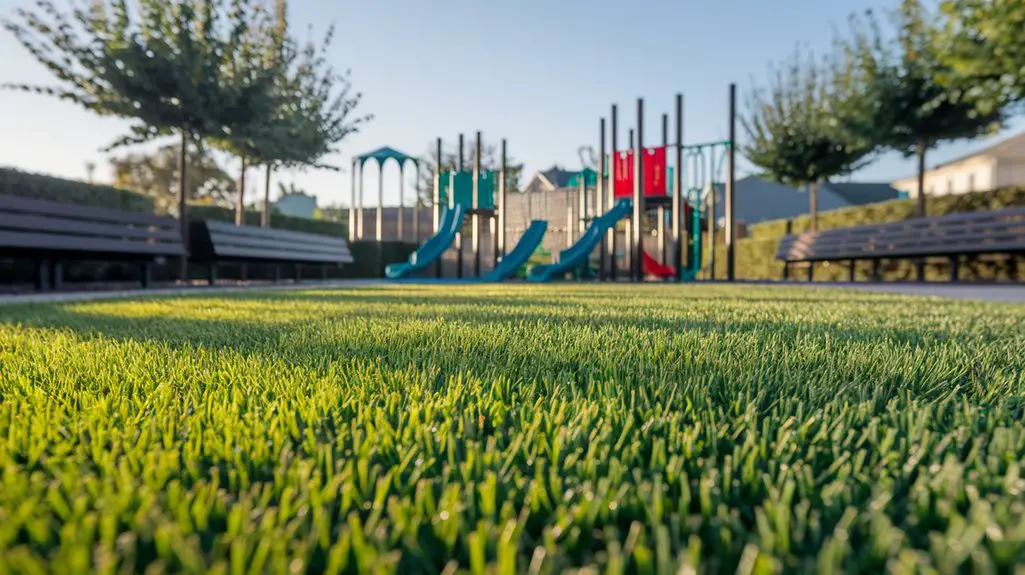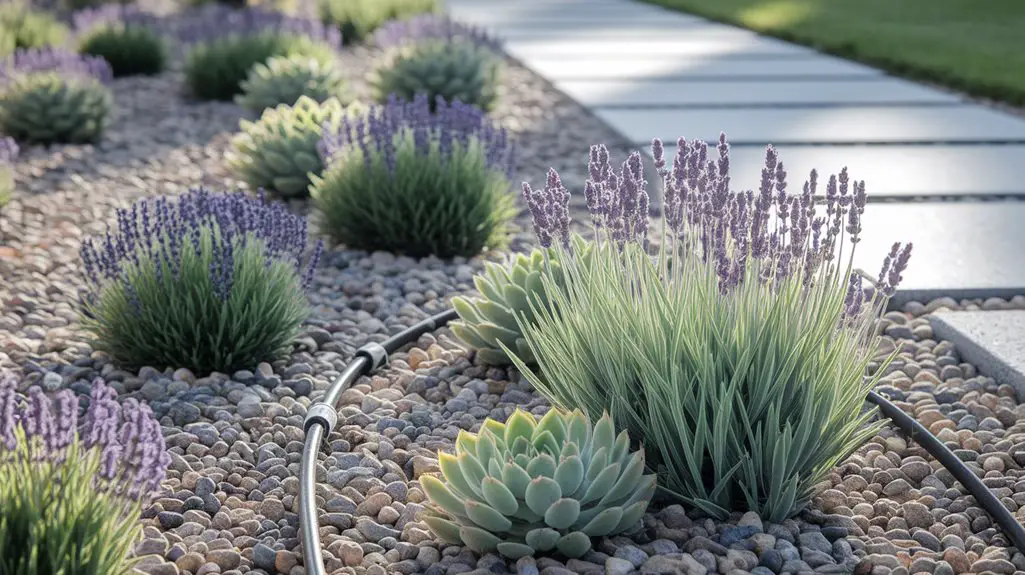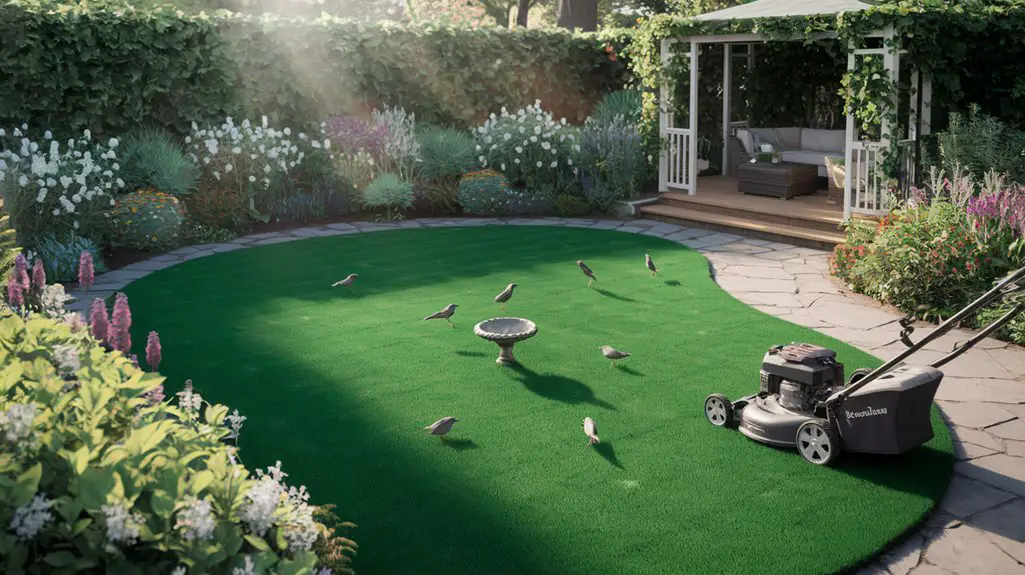Like Eden before the introduction of playthings, your lawn serves as the natural foundation for childhood exploration and growth. You’ll face unique challenges when maintaining play areas that must balance safety with durability. Children’s activities demand grass that can withstand trampling feet yet remain soft enough for inevitable tumbles. The secret lies in selecting the right varieties and implementing maintenance routines that protect both the ecosystem and your little adventurers.
Choosing Child-Safe Grass Varieties
When creating play areas for children, selecting the right grass varieties becomes a critical foundation for both safety and durability. Opt for Kentucky bluegrass or perennial ryegrass, which offer excellent resilience under foot traffic while maintaining soft blades that minimize scratches during falls.
Look for certified low-allergen varieties if your children have sensitivities. Buffalo grass and fine fescues provide eco-conscious alternatives, requiring less water and chemical treatments while still withstanding play activities. These species establish deeper root systems that prevent erosion and create stabilized surfaces.
Consider your regional climate when selecting—warm-season grasses like Bermuda or Zoysia thrive in southern regions, while cool-season varieties perform better in northern landscapes. Incorporating eco-friendly practices not only benefits the environment but also enhances the overall health of your lawn.
The ideal playground turf balances quick recovery from wear with soft texture that cushions impacts.
Proper Mowing Heights for Active Play Zones
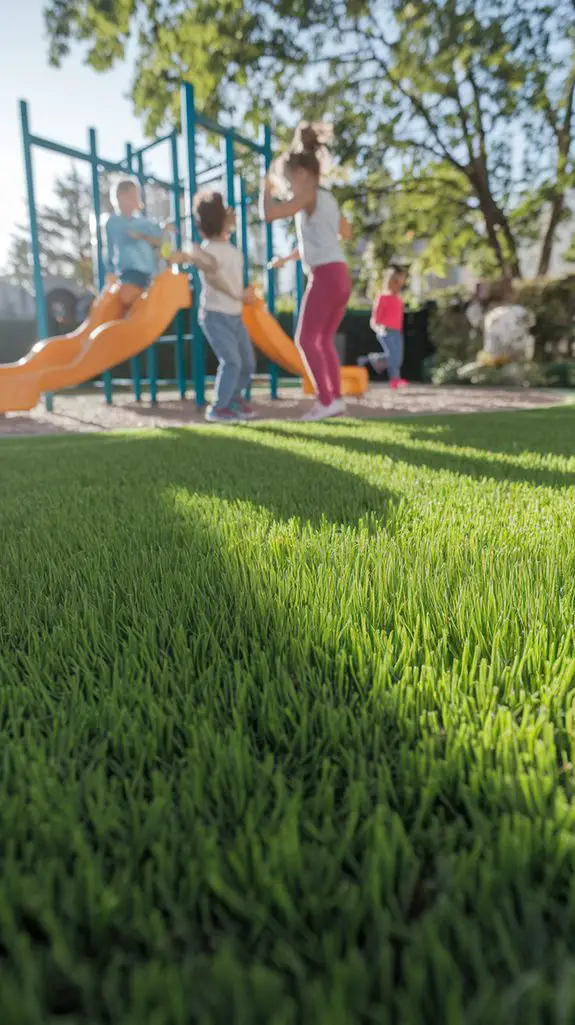
Maintaining the right mowing height complements your grass selection and forms the backbone of a resilient play area. For high-traffic play zones, keep cool-season grasses like Kentucky bluegrass at 2.5-3 inches, allowing deeper root development and improved wear tolerance.
Warm-season varieties such as Bermuda perform best at 1-2 inches, creating a dense, springy surface.
Adjust your mower’s settings seasonally—increase heights by ½ inch during summer stress periods to protect root systems and improve drought resilience.
During active growth phases, follow the one-third rule: never remove more than one-third of the grass blade in a single mowing. This balanced approach promotes lateral growth while maintaining sufficient cushioning for falls and rough play.
Regular, consistent mowing at appropriate heights encourages self-repair and minimizes bare patches in your play ecosystem. Additionally, proper lawn care can enhance the overall appearance and health of your play area.
Natural Pest Management Strategies for Play Areas
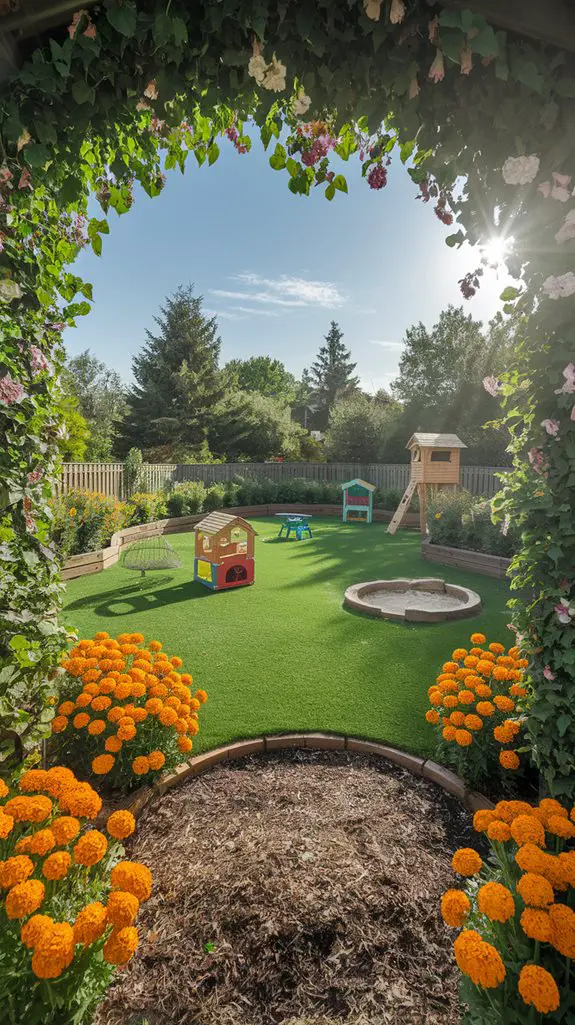
Because children’s safety takes precedence in play areas, natural pest management becomes an essential component of your lawn care ecosystem.
Integrate biological controls that work harmoniously with your yard’s existing balance while keeping harmful chemicals away from sensitive play zones.
Implement these natural pest deterrents for child-safe spaces:
- Introduce beneficial nematodes to soil to target lawn grubs and subterranean pests
- Plant pest-repelling perimeter species like marigolds, lavender, and citronella
- Apply corn gluten meal as a pre-emergent weed suppressant and natural fertilizer
- Establish bat boxes and bird feeders to encourage natural insect predators
Regular monitoring creates a responsive ecosystem approach, allowing you to address potential infestations before they require intervention. Additionally, using sustainable pest management practices not only protects children but also supports the health of your garden environment.
This balanced strategy maintains resilient turf that withstands both play activity and pest pressure.
Maintaining Soil Health Without Harsh Chemicals
In vibrant play-area lawns, healthy soil serves as the fundamental building block for sustainable turf resilience. You’ll discover that maintaining soil health requires a chemical-free approach that supports both plant health and child safety. Embracing organic gardening techniques in your play areas can further enhance the soil ecosystem.
| Natural Amendment | Benefits | Application Frequency |
|---|---|---|
| Compost | Enhances microbial activity | Biannually |
| Worm castings | Adds nutrients gradually | Quarterly |
| Seaweed extract | Promotes root development | Monthly |
| Aerated compost tea | Introduces beneficial microbes | Every 6-8 weeks |
| Biochar | Improves water retention | Annually |
Test your soil pH annually and adjust using limestone for acidity or sulfur for alkalinity. Consider topdressing with 1/4 inch of compost after aeration to replenish organic matter. Remember, healthy soil naturally suppresses pathogens and reduces irrigation needs, creating a resilient ecosystem where children can play safely.
Drainage Solutions for Muddy Play Spaces
Muddy play areas can quickly transform from joyful spaces into unusable swampland when drainage issues persist.
Implementing effective water management strategies preserves both functionality and safety while extending the lifespan of your lawn’s ecosystem. Expert lawn care tips can further enhance your outdoor space by ensuring a healthy environment for play.
Consider these targeted drainage solutions:
- French drains – Install perforated pipes surrounded by gravel to redirect water away from play zones while maintaining soil integrity.
- Rain gardens – Create strategic depressions planted with water-tolerant species to absorb excess moisture naturally.
- Surface grading – Establish a 1-2% slope away from structures to prevent water pooling without disrupting play.
- Permeable materials – Incorporate porous pavers or specialized playground mulch that allows water infiltration while providing cushioning.
You’ll notice improved resilience during wet seasons, reduced maintenance needs, and greater usability of your outdoor play spaces throughout the year.
Wear-Resistant Lawn Techniques for High Traffic
Active play areas naturally endure significant foot traffic that can quickly transform lush grass into patchy, compacted soil when not properly reinforced. Combat this degradation by selecting hardy grass varieties like perennial ryegrass, Kentucky bluegrass, or tall fescue—species engineered for rapid recovery and wear resistance.
Maintain your play area turf at a slightly higher height (3-4 inches) to promote deeper root systems and enhance resilience. Implement a rotation system by temporarily fencing off damaged sections, allowing recovery without abandoning play entirely.
Core aeration twice yearly relieves soil compaction, while light topdressing with compost improves structure without creating uneven surfaces. Improving soil health is essential for maintaining a vibrant and functional lawn in play areas.
For extremely high-traffic zones, consider integrating stepping stones or mulched pathways to channel movement patterns, preserving surrounding turf while maintaining the area’s playful functionality.
Seasonal Lawn Recovery After Intense Play
Seasons dramatically impact your lawn’s recovery needs after periods of intense play and activity. Each climate phase requires tailored rehabilitation strategies to restore resilience and aesthetic appeal to play areas.
- Spring: Apply nitrogen-rich fertilizer while aerating compacted soil, allowing grassroots to access oxygen and nutrients during this prime recovery window.
- Summer: Water deeply but infrequently—morning irrigation prevents evaporation while maintaining 3-4 inch mowing height shields soil from heat stress.
- Fall: Overseed with climate-appropriate grass varieties while applying potassium-rich fertilizer to strengthen root systems before dormancy.
- Winter: Minimize traffic on frost-covered turf and remove debris promptly to prevent fungal diseases when moisture levels peak.
Rotate play zones seasonally to distribute wear patterns, creating a sustainable recreational ecosystem that remains vibrant year-round. Additionally, implementing best lawn care tips can further enhance the durability and appearance of play areas throughout the year.
Conclusion
Your play-ready lawn isn’t just green space—it’s a microhabitat where childhood memories take root. Maintain your ecosystem with proper mowing heights, send those pests packing via telegraph (not chemicals), and implement strategic rotation to heal high-traffic areas. By conditioning soil naturally and selecting resilient grass varieties, you’re creating a sustainable play surface that’s both safe for children and kind to our planet’s delicate web of life.

